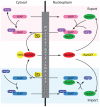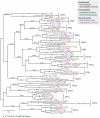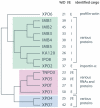Evolution of the karyopherin-β family of nucleocytoplasmic transport factors; ancient origins and continued specialization
- PMID: 21556326
- PMCID: PMC3083441
- DOI: 10.1371/journal.pone.0019308
Evolution of the karyopherin-β family of nucleocytoplasmic transport factors; ancient origins and continued specialization
Abstract
Background: Macromolecular transport across the nuclear envelope (NE) is achieved through nuclear pore complexes (NPCs) and requires karyopherin-βs (KAP-βs), a family of soluble receptors, for recognition of embedded transport signals within cargo. We recently demonstrated, through proteomic analysis of trypanosomes, that NPC architecture is likely highly conserved across the Eukaryota, which in turn suggests conservation of the transport mechanisms. To determine if KAP-β diversity was similarly established early in eukaryotic evolution or if it was subsequently layered onto a conserved NPC, we chose to identify KAP-β sequences in a diverse range of eukaryotes and to investigate their evolutionary history.
Results: Thirty six predicted proteomes were scanned for candidate KAP-β family members. These resulting sequences were resolved into fifteen KAP-β subfamilies which, due to broad supergroup representation, were most likely represented in the last eukaryotic common ancestor (LECA). Candidate members of each KAP-β subfamily were found in all eukaryotic supergroups, except XPO6, which is absent from Archaeplastida. Phylogenetic reconstruction revealed the likely evolutionary relationships between these different subfamilies. Many species contain more than one representative of each KAP-β subfamily; many duplications are apparently taxon-specific but others result from duplications occurring earlier in eukaryotic history.
Conclusions: At least fifteen KAP-β subfamilies were established early in eukaryote evolution and likely before the LECA. In addition we identified expansions at multiple stages within eukaryote evolution, including a multicellular plant-specific KAP-β, together with frequent secondary losses. Taken with evidence for early establishment of NPC architecture, these data demonstrate that multiple pathways for nucleocytoplasmic transport were established prior to the radiation of modern eukaryotes but that selective pressure continues to sculpt the KAP-β family.
Conflict of interest statement
Figures






References
-
- Martin W, Koonin EV. Introns and the origin of nucleus-cytosol compartmentalization. Nature. 2006;440:41–45. - PubMed
-
- Dacks JB, Field MC. Evolution of the eukaryotic membrane-trafficking system: origin, tempo and mode. J Cell Sci. 2007;120:2977–2985. - PubMed
-
- Field MC, Dacks JB. First and last ancestors: reconstructing evolution of the endomembrane system with ESCRTs, vesicle coat proteins, and nuclear pore complexes. Curr Opin Cell Biol. 2009;21:4–13. - PubMed
-
- Mason DA, Stage DE, Goldfarb DS. Evolution of the metazoan-specific importin alpha gene family. J Mol Evol. 2009;68:351–365. - PubMed
Publication types
MeSH terms
Substances
Grants and funding
LinkOut - more resources
Full Text Sources
Molecular Biology Databases

